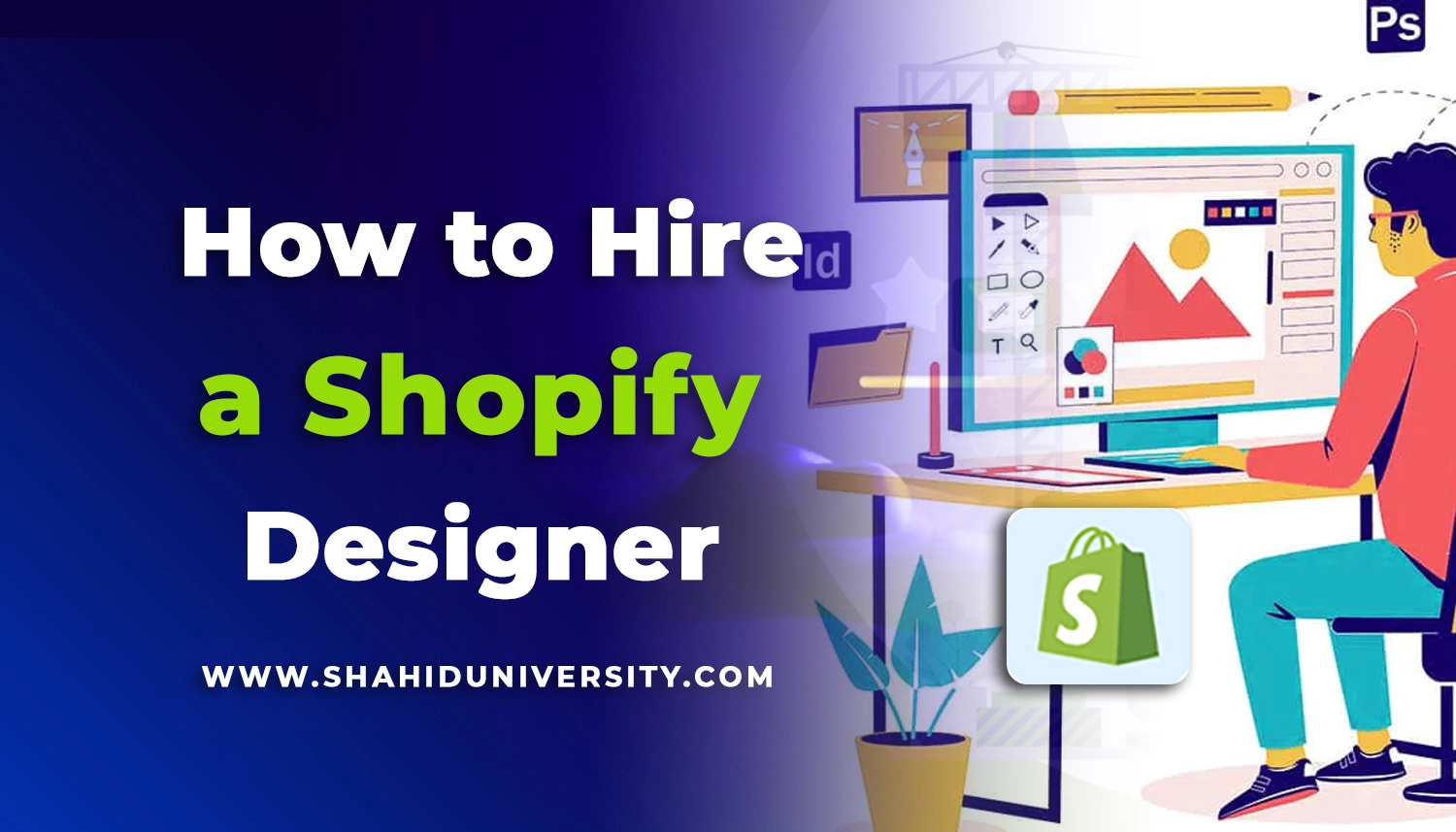Bringing on board a Shopify designer is a crucial step in establishing a successful online presence for your e-commerce business. In a digital age where first impressions hold great significance, the design and functionality of your Shopify store play a pivotal role in both attracting and retaining customers. This article explores the intricate process of enlisting the services of a Shopify designer.
It provides insights into why this decision is of utmost importance, outlines the desirable qualities to seek in a designer, and breaks down the steps involved in making this choice. Whether you’re in the initial stages of launching a new online store or giving a facelift to an existing one, understanding the process of hiring a Shopify designer will empower you to create a visually appealing, user-friendly, and search engine-optimized website that will help your business stand out in the competitive e-commerce landscape.
Why Hire a Shopify Designer?
Engaging the services of a Shopify designer is a strategic decision for those seeking to establish or improve their online presence. These professionals offer a range of advantages. First and foremost, a Shopify designer possesses the expertise needed to create a website that not only looks attractive but also operates smoothly. They comprehend the nuances of the platform, guaranteeing that your site is optimized for performance and user satisfaction.
Additionally, a Shopify designer has the ability to infuse originality into your website, granting it a distinctive and memorable appearance that aligns with your brand. They also possess the technical skills required for web development, responsive design, and SEO, all of which are crucial for success in the online realm. Effective communication is another distinguishing characteristic of a skilled designer, ensuring that your vision is transformed into a compelling and practical online storefront. In a digital landscape where online presence holds significant importance, enlisting the services of a Shopify designer can be a transformative step for your e-commerce business.
What to Look for in a Shopify Designer
When looking for a Shopify designer, there are several vital factors to take into account. First and foremost, experience plays a critical role. It’s crucial to find a designer with a proven history of creating Shopify stores because their familiarity with the platform is incredibly valuable. Moreover, their previous work should reflect their creativity, demonstrating a strong sense of aesthetics and the ability to craft a unique design that aligns with your brand’s identity.
Technical expertise is equally essential. The designer you select should possess in-depth knowledge of web development, responsive design, and search engine optimization (SEO) to ensure that your online store operates smoothly and ranks well in search results. Effective communication skills are also pivotal for a successful partnership, as clear and open dialogue will be essential throughout the design process. Therefore, when in search of a Shopify designer, make sure to prioritize these qualities to guarantee the success of your e-commerce venture.
-
Experience:
The experience of a designer is a critical factor in the success of any project. Experienced designers bring a wealth of knowledge and creative insights to the table. They have a deep understanding of design principles, user experience, and the latest industry trends. Their past projects and client interactions have honed their skills, allowing them to deliver high-quality, effective designs that meet the unique needs of each client. Experienced designers are adept at problem-solving, ensuring that every design decision contributes to a project’s overall success.
-
Creativity:
The creativity of a designer is a powerful asset in the world of design. It’s the ability to think outside the box, bring unique ideas to life, and create visually stunning and innovative solutions. A creative designer can transform ordinary concepts into extraordinary designs that captivate and inspire. Their imagination and artistic flair play a vital role in making designs stand out and leave a lasting impression on the audience.
-
Technical Skills:
A skilled designer possesses a range of technical skills critical for web design and development. These include proficiency in HTML, CSS, and JavaScript for creating and styling web pages. They should be well-versed in responsive design techniques to ensure websites function smoothly across various devices. Knowledge of content management systems like Shopify and SEO principles is essential for optimizing website performance and search engine rankings. Furthermore, expertise in graphic design software, such as Adobe Photoshop and Illustrator, is valuable for creating visually appealing elements.
-
Communication:
Effective communication with your designer is vital for a successful project. Clear and open channels of communication ensure that your vision and expectations are understood and met. You should be able to discuss design ideas, provide feedback, and ask questions throughout the design process. Good communication fosters collaboration and helps in achieving the desired results in your design project.
Steps to Hire a Shopify Designer
- Define Your Requirements: Start by defining what you need for your Shopify store. Consider the design aesthetics, functionality, and any specific features you want.
- Research: Begin your search for Shopify designers. You can look for professionals online, ask for referrals from business colleagues, or explore Shopify’s Expert Marketplace.
- Interview: Conduct interviews with potential designers. This is a crucial step to assess their skills, experience, and compatibility with your vision.
- Portfolio Review: Carefully examine the designer’s portfolio. Look for examples of their previous Shopify projects to gauge their capabilities and style.
- Budget Consideration: Discuss pricing and payment terms with the designer. Make sure the budget aligns with your financial resources and project expectations.
- Agreement: Once you’ve found the right designer, it’s essential to sign a contract. The contract should clearly outline the project scope, timelines, deliverables, and any other terms and conditions.
- Collaboration: Throughout the design and development process, work closely with the designer. Provide feedback, share your ideas, and ensure your vision is being translated into the design.
- Testing: Before the official launch, it’s important to thoroughly test your Shopify website. Check for any bugs, glitches, or issues that need to be resolved.
- Launch: After successful testing and final adjustments, it’s time to launch your new Shopify store. Make it live for customers to access and shop.
Benefits of Hiring a Shopify Designer
- Professional Appearance: One of the foremost advantages of hiring a Shopify designer is the professional appearance they can give your online store. These experts have an eye for aesthetics and can create a visually appealing design that resonates with your brand image.
- User-Friendly Design: Shopify designers understand the importance of a user-friendly website. They ensure that your online store is easy to navigate and provides a seamless shopping experience for your customers. This can lead to higher customer satisfaction and increased sales.
- Optimized for SEO: Shopify designers are well-versed in search engine optimization (SEO) techniques. They can structure your website in a way that improves its visibility on search engines like Google. Higher search engine rankings mean more organic traffic to your store.
- Time-Saving: While you could attempt to design your Shopify store yourself, it can be a time-consuming process, especially if you’re not experienced. Hiring a designer allows you to save time and focus on other aspects of your business while a professional handles the design work efficiently.
- Customization: Every business is unique, and your online store should reflect that uniqueness. Shopify designers have the skills and knowledge to customize your website to suit your brand’s specific needs. This level of customization can set you apart from competitors.
Common Mistakes to Avoid
- Don’t choose a designer solely based on the lowest price, as quality work often comes at a reasonable cost.
- Avoid neglecting effective communication with your designer, as clear and open dialogue is crucial for project success.
- Don’t skip the due diligence of reviewing the designer’s previous work, as it’s a reliable indicator of their capabilities.
- Avoid rushing the decision-making process; take your time to find the right designer who aligns with your vision and brand.
Questions to Ask Potential Designers
During interviews, consider asking the following questions:
- Can you show me examples of your previous Shopify projects?
- What is your approach to creating a unique design for my brand?
- How do you handle responsive design for mobile users?
- What is your process for optimizing the website for search engines?
- What kind of post-launch support do you offer?
Cost of Hiring a Shopify Designer
The cost of hiring a Shopify designer can vary significantly and is influenced by factors like their level of expertise, the complexity of your project, and your specific needs. Designers may use hourly rates, project-based fees, or a combination of both for their pricing. Typically, less experienced designers may charge lower fees, while highly skilled professionals may demand higher rates.
It’s crucial to find a balance between your budget and the quality of work you anticipate. Keep in mind that hiring a skilled designer is an investment in the success of your e-commerce venture. Although it might be tempting to cut costs, opting for a professional designer can result in a more polished and effective Shopify store, ultimately enhancing your online business’s profitability.
Conclusion
To sum up, the decision to hire a Shopify designer is a vital one for any e-commerce venture. These experts have the skills to craft attractive, user-friendly, and well-optimized online stores, and this can greatly impact the success of your business. By following the steps provided in this article, you can ensure that your hiring process is well-informed and productive.
Throughout this article, we’ve stressed the significance of bringing a Shopify designer on board, discussed essential qualities to look for, offered a step-by-step hiring guide, and underscored the numerous benefits. As you embark on this journey, remember to steer clear of common mistakes, draw inspiration from case studies, and ask relevant questions during the interview process.
Your chosen Shopify designer will play a pivotal role in bringing your brand to life online, and their post-launch support will contribute to your site’s ongoing success. With the right designer, your e-commerce business can thrive, delivering a seamless shopping experience for your customers.
FAQs
-
How much does it cost to hire a Shopify designer?
The cost varies depending on the designer’s experience and the scope of your project.
-
Do I need to have a specific design in mind before hiring a designer?
While it helps to have some ideas, a good designer can also help you conceptualize your design.
-
How long does it take to complete a Shopify design project?
The timeline depends on the project’s complexity and your collaboration with the designer.
-
Can I update my Shopify website after it’s live?
Yes, you can make updates and changes to your Shopify website as needed.
-
What should I look for in a designer’s portfolio?
Pay attention to the design aesthetics, functionality, and variety of previous projects to assess their suitability for your brand.








